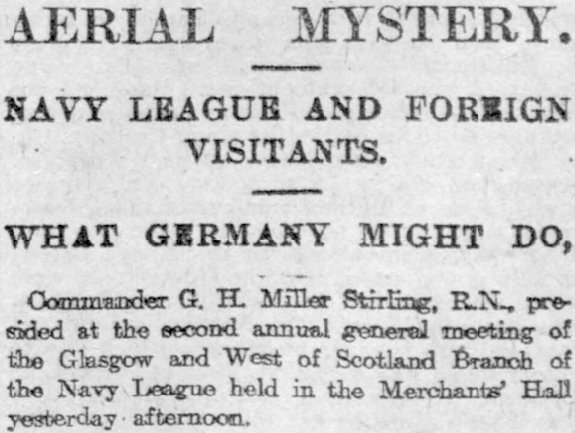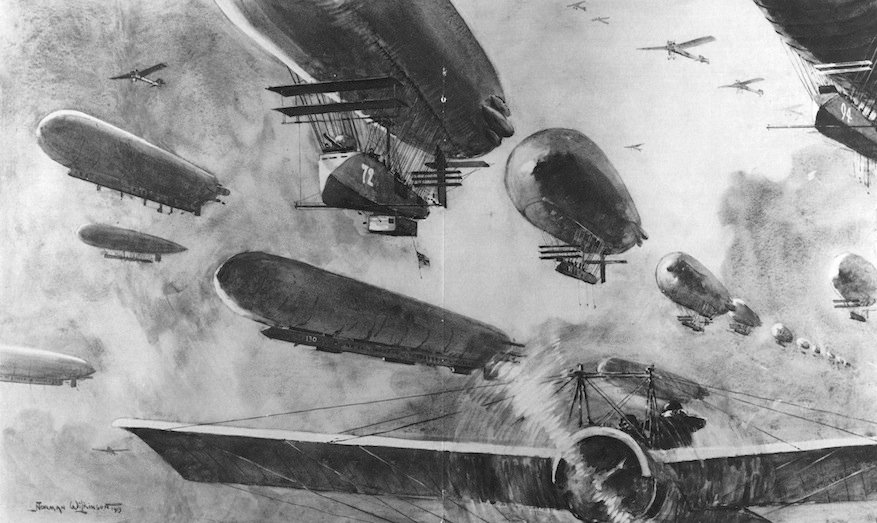
Press coverage of mystery airships hasn’t quite fallen off a cliff, but it is perhaps scrabbling down a rocky slope. Only a handful of newspapers mention them today, and not even yesterday’s startling report from the trawler Othello rates a mention. While there is still considerable (mostly negative) discussion of the new aerial navigation regulations, unlike yesterday very little of it places them in the context of airship sightings. One of the very few to do so is the Irish Times (p. 6):
London is laughing heartily at Mr. McKenna’s naive regulations for stopping the incursions of foreign airships. If it be true, as seems to be the case, that they have been sailing at their ease over our harbours and arsenals, they are hardly to be deterred by the threat of six months’ imprisonment, or to be induced to ‘come down out of that’ by the discharge of a few harmless rockets.
In similar vein, in an article on today’s resumption of Parliament the Manchester Courier suggests that (p. 8)
Recent revelations concerning the visits of foreign airships and the Home Secretary’s regulations, showing as they do that Great Britain has nothing but mere words to combat the aerial menace, might well supply material for some pertinent questions to Ministers. The country is entitled to an authoritative statement without further delay.
Elsewhere in today’s issue the Courier continues its ‘Ships that pass in the night’ campaign with a new article from its ‘special representative in Germany’ (p. 7; above). Much of it is a reexamination of the Sheerness incident, reconstructing the known movements of Zeppelin ‘M.L. 1’ (i.e. L1 AKA LZ14) in the period in question and recapitulating the argument that it deviated from its published course and flew over Britain instead of Germany. Except that this time the Courier‘s correspondent does acknowledge that according to the official account the German airship’s flight was the day before Sheerness. Perhaps for this reason they are open to the theory that Hansa was the culprit: ‘That either the “M.L. 1” or the “Hansa” was the vessel heard over Sheerness appears certain’. But equally, they are still selective in addressing the German denials of responsibility which implicitly and explicitly included L1 and Hansa.

The Courier‘s special representative also provides this map which ‘shows at a glance what may properly be described as the “striking radius” of Germany’s naval dirigibles’. On the German side are named present and planned airship bases; on the British, naval dockyards and bases along with the Armstrong and Vickers shipbuilding yards. The radius shown here appears to be for L1, which has ‘a gas capacity great enough to sustain her for a flight of 1,600 miles at 40 miles an hour’. But
The new naval dirigibles will have the capacity increased to the extent of permitting them to make a flight of 2,000 miles under the same circumstances, which, in the case of the first vessel imply a crew of 25 men, enough fuel for the motors to accomplish the given distance, and a reserve lifting capacity of five tones, which could be utilised in carrying high-explosives.
They will therefore ‘be able to visit any dockyard or naval base in the United Kingdom, drop its cargo of explosives on the selected target and return to its German base with gas and motor fuel to spare’. And, for those who haven’t been paying attention,
A fleet of such airships, given ordinary luck, could inflict terrible damage at all our important dockyards in the course of a single day. While it is unlikely that unfortified English cities would ever be subjected to bombardment from the air, the fact that London is, officially at least, a fortified city might conceivably bring upon her the fate that overtook Paris 42 years ago, though with results infinitely more terrible.
The Courier‘s proposed remedy is the urgent construction ‘of an aerial flotilla numerous enough to promise a warm reception to hostile airships bent on destruction’, as well as, in due course, a fleet of ‘large “ocean-going” dirigible airships […] essential to us if we are to be in a position to return with interest any attack made upon us by foreign air-craft’.
There is some socialist commentary on the scareships today. A Perth socialist (apparently) writing to the Dundee Courier under the pseudonym ‘Anti-Soldier’, in the course of an attack on what he assumes to be a Liberal letter writer who urged workers to join the Territorials, mentions ‘the much-talked-of German invasion and the German (?) phantom airship scare’ (p. 6). The implication seems to be that the German threat is being exaggerated in order to justify armaments and conscription. The Fabian guild socialist weekly New Age, although it is itself critical of ‘daft peacemongers’ (p. 418) is certainly sympathetic to that view, though also to the Territorials (citing favourably the ‘militarist conspiracy’ theory put forward in the Fortnightly Review this month). It opens its leading articles by noting the ‘sudden increase of armaments on the Continent’ this last week: Germany increased the size of its army by 300,000 men; France increased length of service of its conscripts from two to three years (hence also increasing the size of the army); and Russia has also added three corps or 150,000 men (p. 417).
As if this were not enough to startle the industrially jaded nervous system of the modern Englishman, the whole country has been thrown into a state of ludicrous alarm by some jokers who let loose a half-crown gasbag on the Yorkshire moors, an action which was at once followed by circumstantial rumours concerning German airships — airships which not merely turned up in half a dozen places at once, but were provided which searchlights clearer and much more powerful than any yet devised by human beings.
The New Age contrasts this scare to ‘The spectre of Boney a century ago […] never more terrifying than the spectre of German airships today’. But back then Napoleon actually did have plans to invade Britain, even assembled an army for the purpose; and yet ‘the Englishmen of the period quietly faced these proposals as courageous men might have been expected to do’, in part by organising the Volunteer system for defence. It’s different today:
Our contemporaries, if we can believe the Press, do not attempt to face the alleged German peril at all; they simply scurry into their industrial rabbit-warrens like some timid animal afraid of the sight of a man. In writing as they do, the newspapers undoubtedly represent the views of a large proportion of their readers; but of their middle-class readers, we firmly believe; not of their working-class readers. For the economic, industrial, social, and political system of this country has been for decades in the hands of the middle-classes, and ninety-nine newspapers out of a hundred are published in the interests of this ruling class. The working classes, where the Press is concerned, still remain beyond the pale, even in their own papers; for, unlike Germany and France, and even Italy, we have not yet in England a strong Labour Press, free entirely from capitalist support and capitalist subsidies in the form of advertisements.
It’s not immediately clear what the New Age thinks would constitute facing the allege German peril, as it doesn’t address the actions of the government (e.g. the new aerial navigation regulations) or any other alternative proposals (e.g. the £1 million for air defence most recently demanded by the Navy League, as many papers report today). All that can be said is that it is against conscription and the bourgeois press, but for voluntarism and a labour press.
The only phantom airship report today comes, ironically enough, from Germany. There’s a certain amount of satisfaction at this, evident in the Dundee Courier‘s headline: ‘GERMANS ARE SCARED BY APPEARANCE OF STRANGE AIRSHIP’ (p. 4). According to the Daily Express (p. 6),
Germany is now engaged in solving the mystery of a strange airship. An unknown vessel was seen last night [4 March 1913] over Tarnovitz [sic], in Silesia, by numerous witnesses. It is believed that Russian officers have been surveying Tarnovitz.
The newspapers publish an official notice promising a large money prize to any one giving the police information enabling them to capture the airship.
The Dundee Courier adds that the reward was announced by ‘Count Lemberg, Military Governor of Silesia’ (p. 4).
From the airship sceptics come two new explanations today. The first applies to the airship sightings in and near Grimsby and appeared in the radical Westminster Gazette (apparently from the Sheffield Daily Telegraph), though the account here is from the incredulous Globe: ‘Quite seriously we are asked to believe that what the trained eyes of Capt. Lundie […] specifically declared to be an airship, was nothing more than a box kite‘ (p. 7). There does seem to be some strong prima facie evidence for the box kite theory, namely a ‘contents bill’ and a policeman’s statement:
The ‘discovery’ was made by a constable of Grimsby, who saw the ‘scareship’ flash across the sky above him while on duty at night. Further, ‘he could plainly see two lights exhibited on either side of the dark body. After passing above him, the scareship seemed to dart downward towards a plantation at the rear of Weelsby Hall, the residence of Mr. G. F. Sleight.
Reading on, we find that upon going to the place ‘he discovered a couple of young men packing up the remains of a huge box kite, some 15ft. long by 5ft. wide. Attached to it were a couple of electric lamps working from a storage battery. The kite had made an involuntary descent, and had come to grief, the cross-stays being smashed. Its possessors admitted that they had been amusing themselves by flying the kite for some evenings.’
The Globe does not deny that this box kite might ‘have been mistaken by some people for an airship, but to suggest that this is a solution of the mystery is simply trivial’. And it has a point: as it goes on to remind readers, whereas the hoaxer’s kite is said to have had two electric lights attached, the airship seen by Captain Lundie and Second Officer Williams of the City of Leeds had no lights at all.
The other new theory is from the Aberdeen Journal and is for airships seen near Aberdeen lately (p. 4):
During the past few nights the atmosphere in the north of Scotland, and particularly in Aberdeen, has been electrically disturbed, and on Tuesday night there was a good deal of lightning in and around the city and up to Deeside. Flashes were seen in the firmament, and although they resembled to a degree the searchlights that might be flashed from an airship there was no doubt that they were lightning, as they prevailed during a perfect hurricane in which no airship yet made could have existed.
Although the point about the storm is well taken, on the whole this seems unconvincing: could the exceedingly brief but brilliant flashes of a lightning bolt really be mistaken for the more constant illumination of a searchlight?
![]() This work is licensed under a Creative Commons Attribution-NonCommercial-NoDerivatives 4.0 International License.
Permissions beyond the scope of this license may be available at http://airminded.org/copyright/.
This work is licensed under a Creative Commons Attribution-NonCommercial-NoDerivatives 4.0 International License.
Permissions beyond the scope of this license may be available at http://airminded.org/copyright/.






Pingback: Friday, 7 March 1913
Pingback: Saturday, 22 March 1913